Research on the Early-Age Cracking of Concrete Added with Magnesium Oxide under a Temperature Stress Test Machine
Abstract
:1. Introduction
2. Methods and Materials
2.1. Materials
- (1)
- Cement
- (2)
- Coarse and fine aggregates
- (3)
- Magnesium oxide expansion agent
- (4)
- Mix proportion of concrete
2.2. Experimental Methods
2.2.1. Specimen Preparation
- The insulation cover plate was removed from the upper part of the TSTM, and a double layer of plastic film was added to the concrete mold. Prior to applying the film, insulation panels were positioned on the three surfaces that came into contact with the concrete within the effective length of the mold to minimize temperature errors resulting from the high thermal conductivity of the metal.
- The mixed concrete was poured into a concrete test chamber with attached plastic film, ensuring that the pouring height was 0.5 cm from the top end face of the concrete clamp mold. Based on the concrete’s fluidity, two sections of ribbed steel bars were positioned at the stress concentration points at both ends at the appropriate times to prevent stress concentration and premature fracture during the testing process.
- After the concrete was poured, a layer of cling film was applied to the concrete surface, ensuring that it was tightly adhered to prevent moisture loss and isolate drying shrinkage. At this stage, the preparation of concrete specimens was typically completed.
2.2.2. The Experimental Equipment
2.2.3. Working Mode of TSTM
2.2.4. Test Method
- After selecting the operating mode (free deformation mode or fully constrained mode), the TSTM was initiated, the internal core temperature of the specimen was monitored, a temperature control system was employed to maintain the concrete specimen in a semi-adiabatic state, and the synchronous motor was simultaneously activated to ensure that the specimen was in a 100% constrained state.
- Once the internal temperature of the concrete specimen reached its peak (i.e., the internal core temperature stabilized), the temperature control system was turned off, and the concrete specimen was allowed to cool naturally until it developed cracks.
- Once the specimen cracked, the test was concluded, and the observational data were collected for analysis.
3. Results and Discussion
3.1. Effect of MEA on the Expansion Coefficient of Concrete
3.2. Effect of MEA on the Autogenous Shrinkage of Concrete
3.3. Effect of MEA on the Restraint Stress of Concrete
3.4. Investigation of the Early-Age Stress Relaxation of Concrete Incorporated with MEA
4. Development and Validation of the Predictive Model for Restraint Stress
- Thermal expansion coefficient;
- Autogenous shrinkage;
- Modulus of elasticity;
- Relaxation coefficient.
4.1. Selection of Early Autogenous Shrinkage Model for Concrete Mixed with MEA
4.2. Investigation of the Early-Age Elastic Modulus of Concrete Incorporated with MEA
- 1.
- Lin Zhi Hai elastic modulus model [5]:
- 2.
- CEB/FIP MC90 [48]:
4.3. Validation of the Predictive Model for Restraint Stress
5. Conclusions
- 1.
- Temperature stress tests were performed on four types of concrete mix proportions, ranging from free deformation tests to fully restrained tests. Based on the experiments, the deformation and mechanical properties of concrete with different MEA admixtures were investigated. The experimental data indicate that with the continuous increase in MEA dosage, the temperature expansion coefficient, the autogenous shrinkage value, and the free deformation value of concrete exhibit a trend of initially increasing and then decreasing. The peak expansion stress and cracking stress gradually increase, while the stress relaxation level continues to increase, with a maximum increase of 65.5%. However, when the MEA dosage exceeds 5%, there is no significant increase in stress relaxation.
- 2.
- The comparison of the restraint stress model results with the measured restraint stress demonstrates that the early model can predict the restraint stress during the tensile stress relaxation phenomenon after 25 h.
Author Contributions
Funding
Institutional Review Board Statement
Informed Consent Statement
Data Availability Statement
Acknowledgments
Conflicts of Interest
References
- Klemczak, B.; Batog, M.; Pilch, M.; Zmij, A. Analysis of cracking risk in early age mass concrete with different aggregate types. Procedia Eng. 2017, 193, 234–241. [Google Scholar] [CrossRef]
- Zhu, Y. Experimental Investigation and Theoretical Modeling on Early-Age Shrinkage Cracking in Concrete. Master’s Thesis, Zhejiang University, Hangzhou, China, 2005. [Google Scholar]
- Byfors, J. Plain Concrete at Early Ages. CBI Forsk. 1980, 3, 465. [Google Scholar]
- Lyman, C.G. Growth and Movement in Portland Cement Concrete; Oxford University Press: Oxford, UK, 1934. [Google Scholar]
- Lin, Z.H. Quantitative Evaluation of the Effectiveness of Expansive Concrete as a Countermeasure for Thermal Cracking and the Development of Its Practical Application. Ph.D. Thesis, University of Tokyo, Tokyo, Japan, 2006. [Google Scholar]
- Wei, D. Experimental Research and Theoretical Analysis of the Thermal Expansion Coefficient in Early-Age Cement-Based Materials. Ph.D. Thesis, Hohai University, Nanjing, China, 2007. [Google Scholar]
- ACI 318-05; Building Code Requirements for Structural Concrete and Commentary. American Concrete Institute: Farmington Hills, MI, USA, 2005.
- Maekawa, K.; Ishida, T.; Kishi, T. Multi-Scale Modeling of Concrete Performance. J. Adv. Concr. Technol. 2003, 1, 91–126. [Google Scholar] [CrossRef]
- Guo, L.; Cai, H.Y. Experimental study on RCC character of additive MgO and simulation of crack prevention in high temperature construction. Adv. Mater. Res. 2011, 368, 651–654. [Google Scholar] [CrossRef]
- Chen, C.L.; Tang, C.S.; Zhao, Z.H. Application of MgO concrete in China Dongfeng Arch Dam foundation. Adv. Mater. Res. 2011, 168, 1953–1956. [Google Scholar] [CrossRef]
- Gao, P.W.; Lu, X.L.; Tang, M.S. Shrinkage and expansive strain of concrete with fly ash and expansive agent. J. Wuhan Univ. Technol. -Mater. Sci. Ed. 2009, 24, 150–153. [Google Scholar] [CrossRef]
- ASTM C1581-04; Standard Test Method for Determining Age at Cracking and Induced Tensile Stress Characteristics of Mortar and Concrete under Restrained Shrinkage. American Society for Testing and Materials: Philadelphia, PA, USA, 2004.
- AASHTO T363-2017; Standard Method of Test for Evaluating Stress Development and Cracking Potential due to Restrained Volume Change Using a Dual Ring Test. American Association of State Highway and Transportation Officials: Washington, DC, USA, 2017.
- Wang, L.; Li, G.; Li, X. Influence of reactivity and dosage of MgO expansive agent on shrinkage and crack resistance of face slab concrete. Cem. Concr. Compos. 2022, 126, 104333. [Google Scholar] [CrossRef]
- Wang, X.F.; Dong, C.Y. Influence of seawater and sea sand on early-age performance and cracking sensitivity of concrete. J. Build. Eng. 2023, 79, 107811. [Google Scholar] [CrossRef]
- Ou, G.F. New insights into restrained stress and deformation mechanisms of concretes blended with calcium sulfoaluminate and MgO expansive additives using multi-scale techniques. Constr. Build. Mater. 2023, 371, 130737. [Google Scholar] [CrossRef]
- Zhang, J.; Lv, T. Effects of fly ash on MgO-based shrinkage-compensating cement: Microstructure and properties. Constr. Build. Mater. 2022, 339, 127648. [Google Scholar] [CrossRef]
- Ye, Y.; Liu, Y.; Shi, T. Effect of Nano-Magnesium Oxide on the Expansion Performance and Hydration Process of Cement-Based Materials. Materials 2021, 14, 3766. [Google Scholar] [CrossRef]
- Guo, J.; Zhang, S.; Qi, C. Effect of calcium sulfoaluminate and MgO expansive agent on the mechanical strength and crack resistance of concrete. Constr. Build. Mater. 2021, 299, 123833. [Google Scholar] [CrossRef]
- GB175-2007; Common Portland Cement. Standards Press of China: Beijing, China, 2007.
- GB/T 23439-2017; Expansive Agents for Concrete. Standards Press of China: Beijing, China, 2017.
- JGJ/T 283-2012; Technical Specification for Application of Self-Compacting Concrete. China Architecture & Building Press: Beijing, China, 2012.
- Springenschmid, R.; Breitenbucher, R.; Mangold, M. Development of the cracking frame and the temperature-stress testing machine. Chapman Hall 1995, 5, 137–144. [Google Scholar]
- Bjøntegaard, Ø. Basis for and Practical Approaches to Stress Calculations and Crack Risk Estimation in Hardening Concrete Structures—State of the art. SINTEF Build. Infrastruct. 2011, 31, 33–55. [Google Scholar]
- Lura, P.; van Breugel, K.; Maruyama, I. Effect of curing temperature and type of cement on early-age shrinkage of high-performance concrete. Cem. Concr. Res. 2001, 31, 1867–1872. [Google Scholar] [CrossRef]
- Aly, T.; Sanjayan, J.G. Shrinkage-cracking behavior of OPC-fiber concrete at early-age. Mater. Struct. 2010, 43, 755–764. [Google Scholar] [CrossRef]
- Aly, T.; Sanjayan, J.G. Shrinkage cracking properties of slag concretes with one-day curing. Mag. Concr. Res. 2008, 60, 41–48. [Google Scholar] [CrossRef]
- TAly; Sanjayan, J.G.; Collins, F. Effect of polypropylene fibers on shrinkage and cracking of concretes. Mater. Struct. 2008, 41, 1741–1753. [Google Scholar]
- Kovler, K. Testing system for determining the mechanical behaviour of early age concrete under restrained and free uniaxial shrinkage. Mater. Struct. 1994, 27, 324–330. [Google Scholar] [CrossRef]
- Igarashi, S.; Bentur, A.; Kovler, K. Autogenous shrinkage and induced restraining stresses in high-strength concretes. Cem. Concr. Res. 2000, 30, 1701–1707. [Google Scholar] [CrossRef]
- Altoubat, S.A.; Lange, D.A. Creep, shrinkage, and cracking of restrained concrete at early age. ACI Mater. J. 2001, 98, 323–331. [Google Scholar]
- Wei, Y.; Hansen, W. Early-age strain–stress relationship and cracking behavior of slag cement mixtures subject to constant uniaxial restraint. Constr. Build. Mater. 2013, 49, 635–642. [Google Scholar] [CrossRef]
- Wei, Y.; Hansen, W. Tensile creep behavior of concrete subject to constant restraint at very early ages. J. Mater. Civ. Eng. 2013, 25, 1277–1284. [Google Scholar] [CrossRef]
- Hammer, T.A.; Fosså, K.T.; Bjøntegaard, Ø. Cracking tendency of HSC: Tensile strength and self generated stress in the period of setting and early hardening. Mater. Struct. 2007, 40, 319–324. [Google Scholar] [CrossRef]
- Shen, D.J.; Jiao, Y.; Gao, Y.; Zhu, S.S.; Jiang, G.Q. Influence of ground granulated blast furnace slag on cracking potential of high performance concrete at early. Constr. Build. Mater. 2020, 241, 117839. [Google Scholar] [CrossRef]
- Zhao, Z.F.; Wang, K.J.; Lange, D.A.; Zhou, H.G.; Wang, W.L. Creep and thermal cracking of ultra-high volume fly ash mass concrete at early age. Cem. Concr. Compos. 2019, 99, 191–202. [Google Scholar] [CrossRef]
- Li, S.; Mo, L.; Deng, M. Mitigation on the autogenous shrinkage of ultra-high performance concrete via using MgO expansive agent. Constr. Build. Mater. 2021, 312, 125422. [Google Scholar] [CrossRef]
- Chen, X.; Yang, H.; Zhou, S. Sensitive evaluation on early cracking tendency of concrete with inclusion of light-burnt MgO. J. Wuhan Univ. Technol.-Mater. Sci. Ed. 2011, 26, 1018–1022. [Google Scholar] [CrossRef]
- Zhang, T. Studies on Influencing Factors of Cracking Sensitivity of Concrete at Early Ages. Ph.D. Thesis, Tsinghua University, Beijing, China, 2006. [Google Scholar]
- Gao, G.B.; Qian, C.X.; Zhu, C.F. Effect of fly ash on thermal expansion coefficient of concrete. J. Southeast Univ. 2006, 36, 185–190. [Google Scholar]
- Zhang, Z.; Li, S.; Chen, P. Mitigating shrinkage in ultra-high performance concrete using MgO expansion agents with different activity levels. Front. Mater. 2022, 9, 1033467. [Google Scholar] [CrossRef]
- Bouali, A.; Grairia, S.; Nettour, D. Instrumented indentation based methods to assess fracture toughness (KIC) of self-compacting concrete: Influence of water to binder (w/b) ratio and type of concrete. Eng. Fract. Mech. 2022, 275, 108796. [Google Scholar] [CrossRef]
- Sherir, M.A.A.; Hossain, K.M.A.; Lachemi, M. Self-healing and expansion characteristics of cementitious composites with high volume fly ash and MgO-type expansive agent. Constr. Build. Mater. 2016, 127, 80–92. [Google Scholar] [CrossRef]
- Telford, T. CEB/FIP Model Code 1990; Thomas Telford Publishing: London, UK, 1993. [Google Scholar]
- Martin, L.H. Concrete Design to EN 1992; CRC Press: Boca Raton, FL, USA, 2005. [Google Scholar]
- Tazawa, E.-I. (Ed.) Autogenous Shrinkage of Concrete; CRC Press: Boca Raton, FL, USA, 1999. [Google Scholar]
- RILEM Technical Committee TC-242-MDC. RILEM draft recommendation: TC-242-MDC multi-decade creep and shrinkage of concrete: Material model and structural analysis*. Mater. Struct. 2015, 48, 753–770. [Google Scholar] [CrossRef]
- Tang, S.; Huang, D.; He, Z. A review of autogenous shrinkage models of concrete. J. Build. Eng. 2021, 44, 20–25. [Google Scholar] [CrossRef]


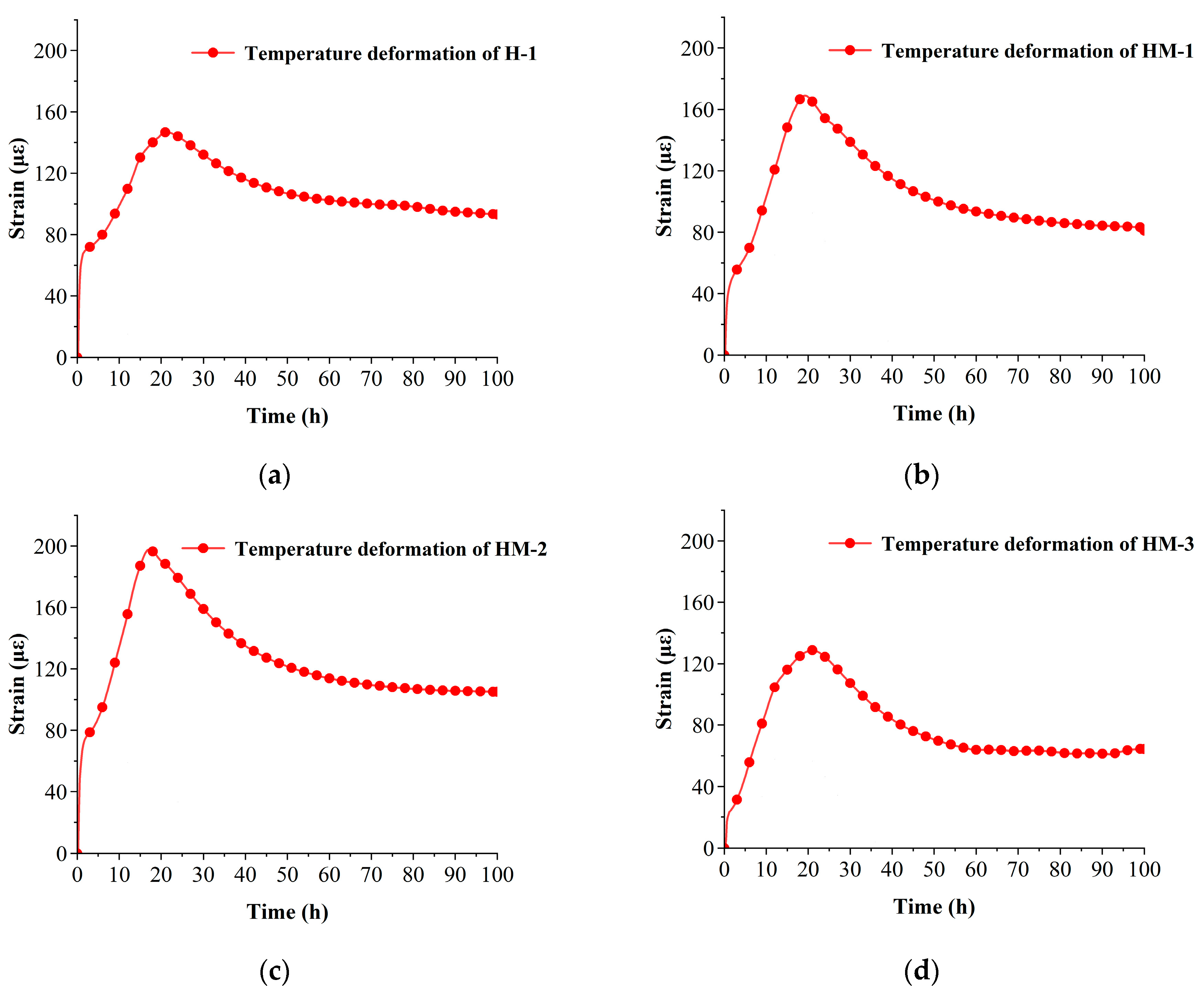
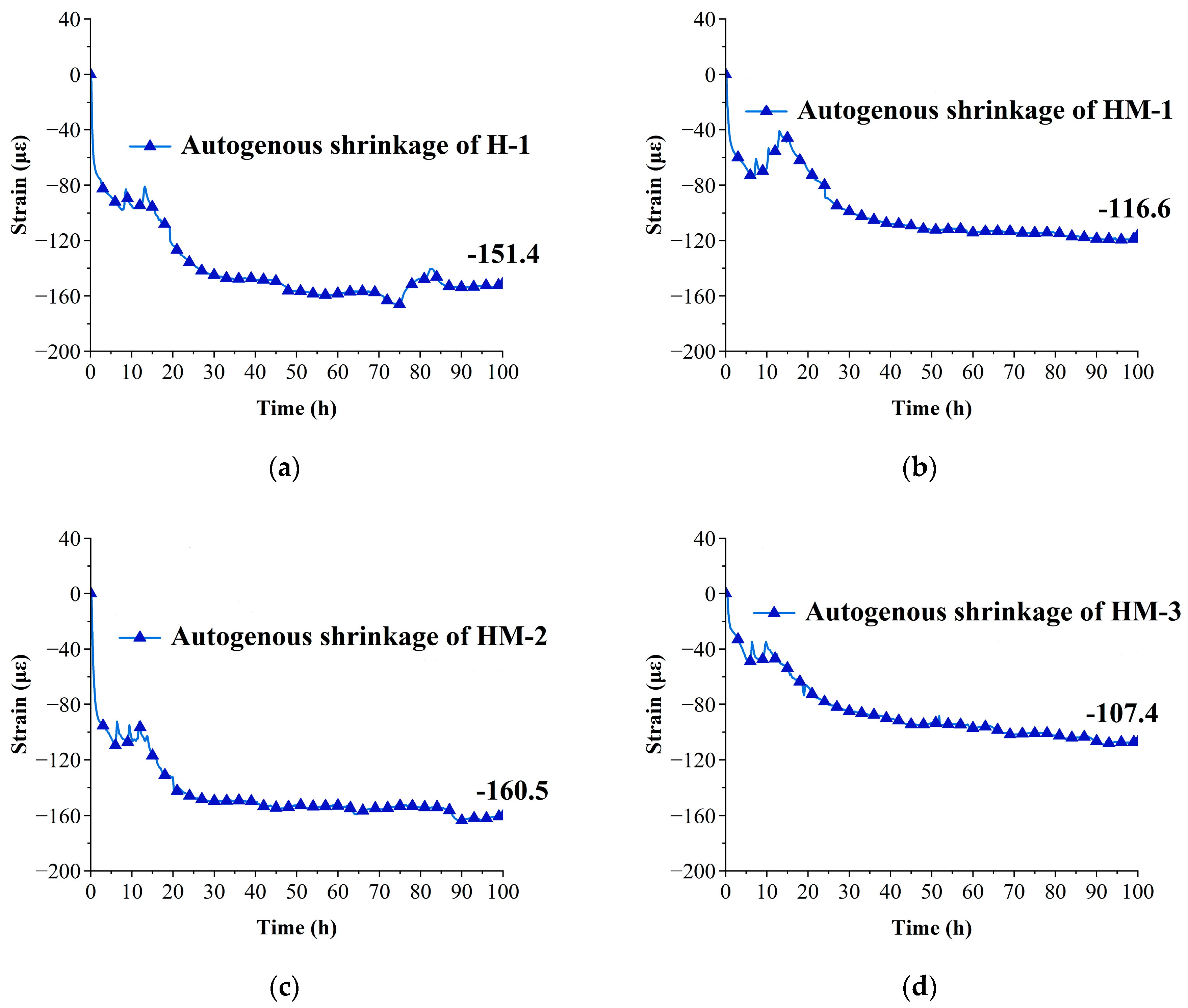
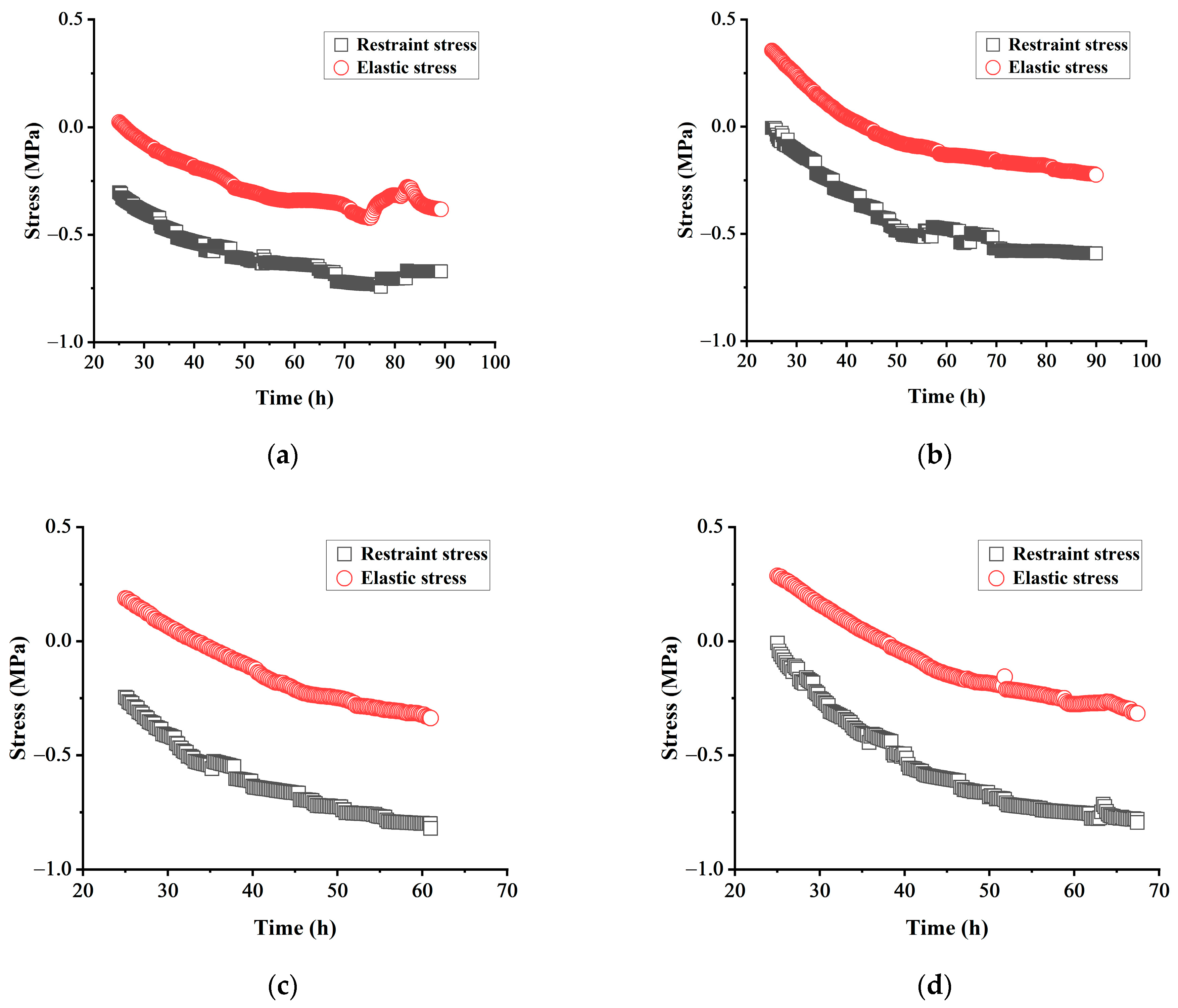
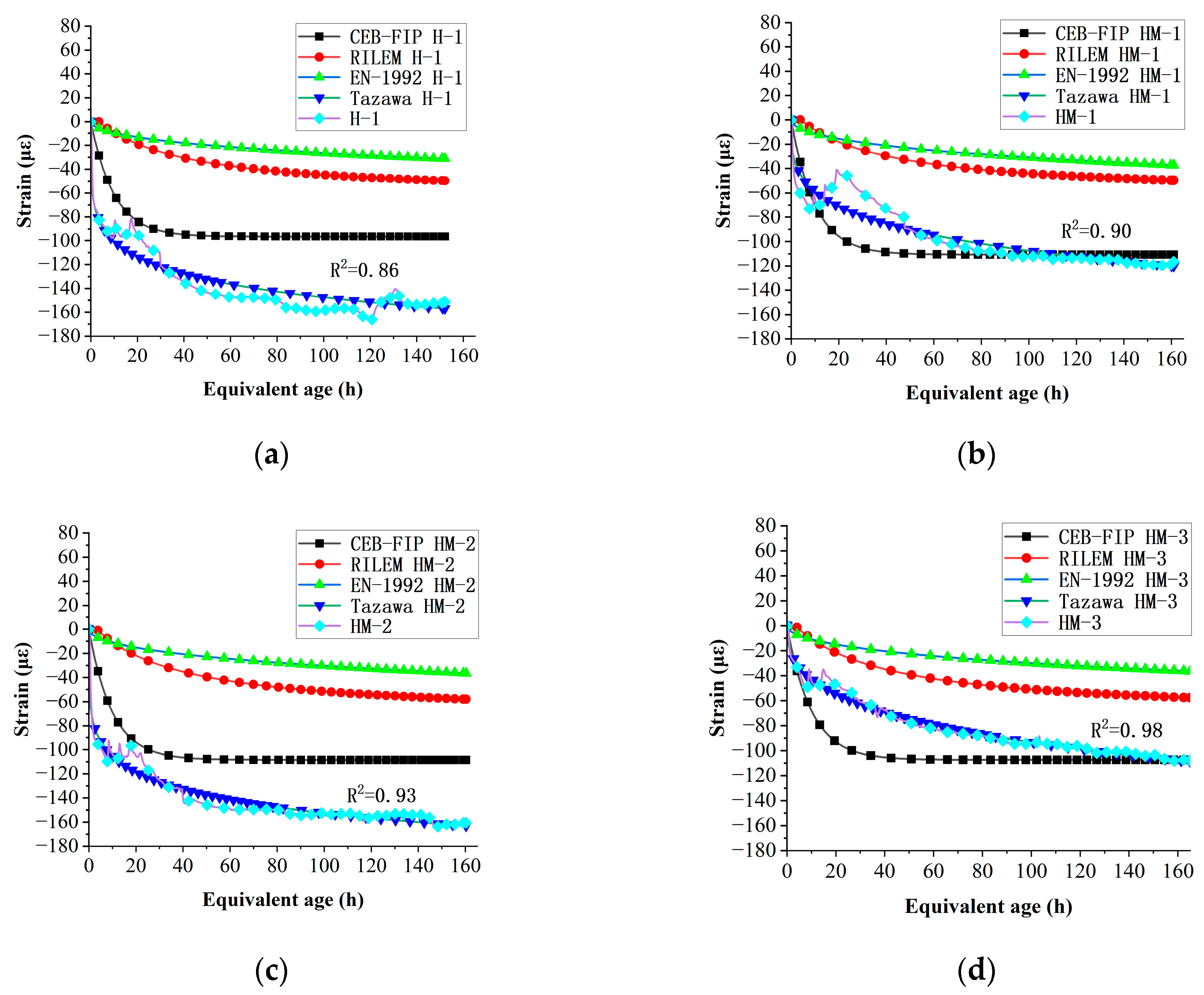
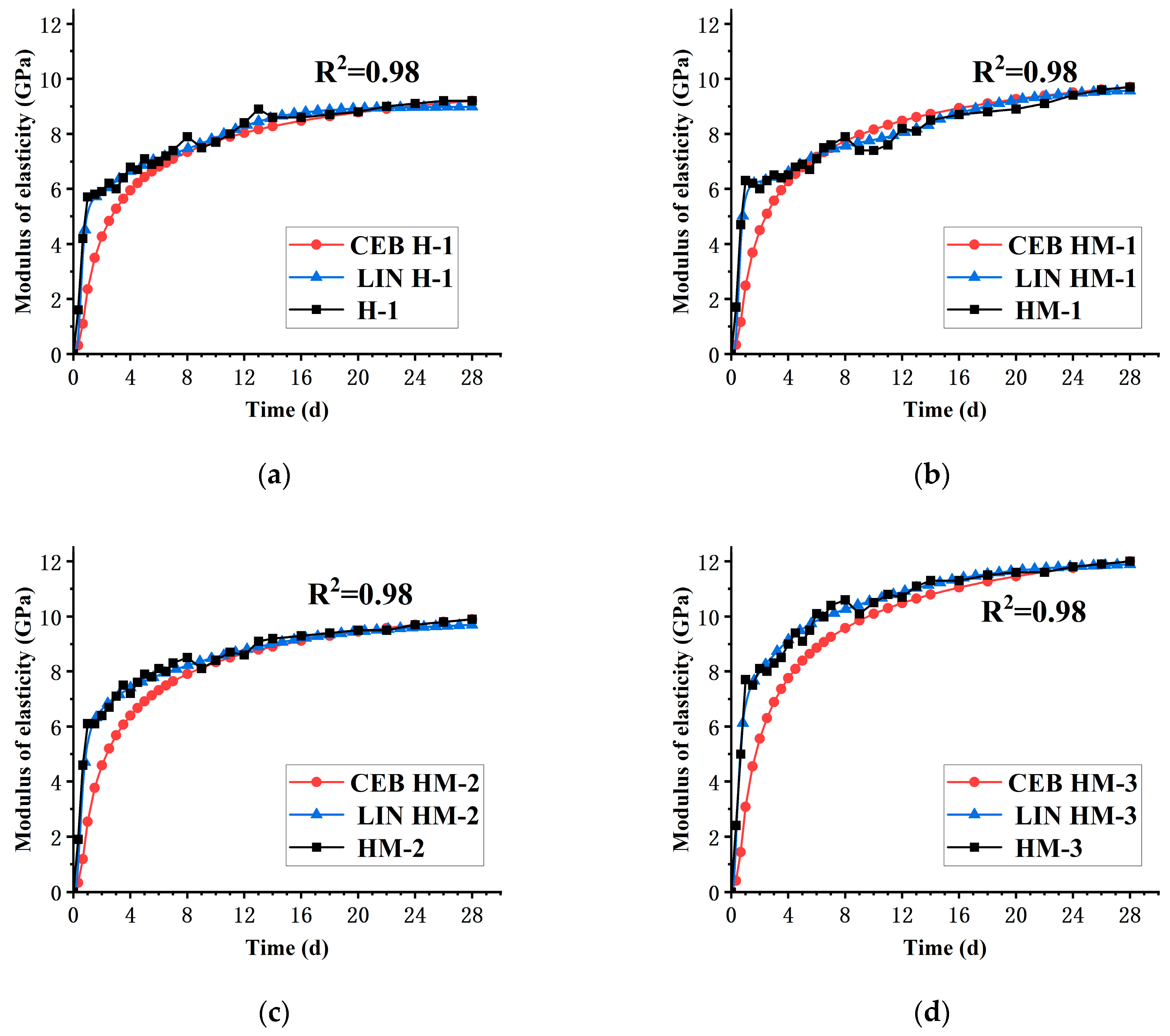
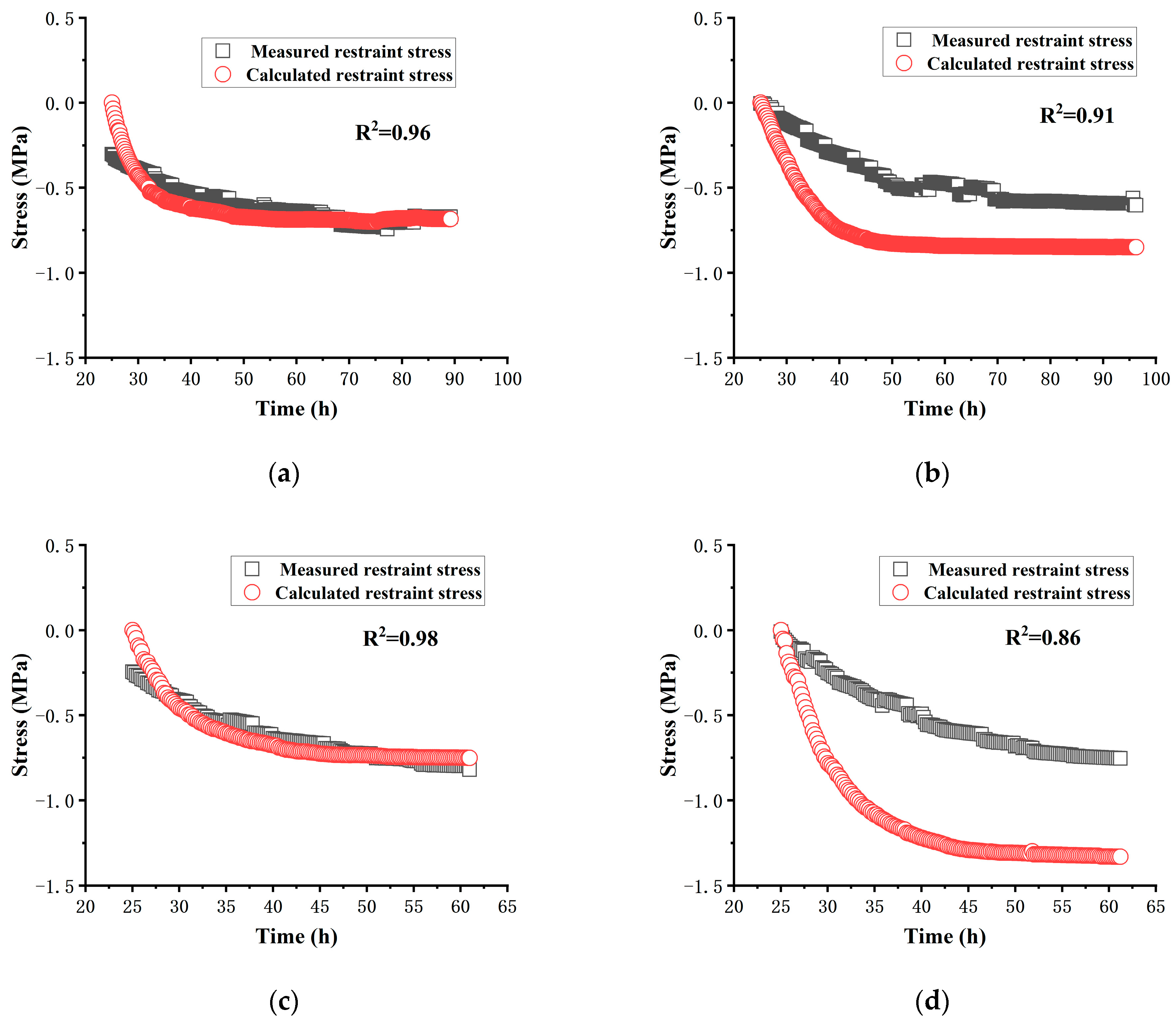
| Quality Index | |||||||||||
|---|---|---|---|---|---|---|---|---|---|---|---|
| Performance Index | Setting Time | Compressive Strength /MPa | Flexural Strength /MPa | MgO (%) | SO3 (%) | Cl− (%) | Loss on Ignition (%) | Bulk Density t/m3 | |||
| Initial Setting Time (min) | Final Setting Time (min) | 3d | 28d | 3d | 28d | ||||||
| PO42.5 | 172 | 234 | 27.2 | 51.7 | 5.5 | 8.2 | 3.71 | 2.51 | 0.043 | 4 | 1.3 |
| GB175-2007 | ≥45 | ≤600 | ≥17 | ≥42.5 | ≥3.5 | ≥6.5 | ≤5.0 | ≤3.5 | ≤0.06 | ≤5.0 | — |
| Coarse Aggregate Type (mm) | Content (%) | |||||
|---|---|---|---|---|---|---|
| 2.5~5 mm | 5~10 mm | 10~15 mm | 15~20 mm | 20~25 mm | Total | |
| 5~10 | 7.5 | 92.5 | 0 | 0 | 0 | 100 |
| 10~20 | 0 | 0 | 77.8 | 22.2 | 0 | 100 |
| MEA | Technical Requirement | |||||
|---|---|---|---|---|---|---|
| Setting Time | Limit Expansion Rate/% | Compressive Strength/MPa | ||||
| Initial Setting Time/min | Final Setting Time/min | 7d in Water | 21d in the Air | 7d | 28d | |
| Experimental results | 206 | 256 | 0.040 | −0.014 | 35.2 | 45.3 |
| Standard requirements | ≥45 | ≤600 | ≥0.035 | ≥−0.015 | ≥22.5 | ≥42.5 |
| Group No | Water–Binder Ratio | Water | Cement | Fly Ash | MgO | Coarse Aggregate | Fine Aggregate | Sand Percentage | Water Reducing Agent |
|---|---|---|---|---|---|---|---|---|---|
| (kg) | (kg) | (kg) | (kg) | (kg) | (kg) | (%) | (kg) | ||
| H-1 | 0.34 | 182 | 352 | 186 | 0 | 892 | 805 | 47.4 | 1.60 |
| HM-1 | 0.34 | 182 | 352 | 186 | 16.13 | 892 | 805 | 47.4 | 1.66 |
| HM-2 | 0.34 | 182 | 352 | 186 | 26.88 | 892 | 805 | 47.4 | 1.70 |
| HM-3 | 0.34 | 182 | 352 | 186 | 43.00 | 892 | 805 | 47.4 | 1.74 |
| Group No | Thermal Expansion Coefficient |
|---|---|
| H-1 | 3.36 |
| HM-1 | 4.21 |
| HM-2 | 4.17 |
| HM-3 | 3.61 |
| Group No | Peak Value of Expansion Stress | Cracking Stress |
|---|---|---|
| H-1 | 0.12 | −0.67 |
| HM-1 | 0.18 | −1.20 |
| HM-2 | 0.24 | −1.28 |
| HM-3 | 0.32 | −1.31 |
| Group No | Maximum Tensile Stress | Corresponding Elastic Stress | Relaxation Coefficient |
|---|---|---|---|
| H-1 | 0.67 | 0.38 | 1.76 |
| HM-1 | 0.60 | 0.24 | 2.50 |
| HM-2 | 0.82 | 0.34 | 2.41 |
| HM-3 | 0.80 | 0.32 | 2.50 |
| Autogenous Shrinkage Model | Parameter Description |
|---|---|
| CEB-FIP [44]: | , , is 1d and t is the age of the concrete (d). |
| EN-1992 [45]: | represents the autogenous shrinkage of the concrete at the moment , is the compressive strength of the concrete cylinder at 28 days (MPa), and t is the age of the concrete (d). |
| Tazawa [46]: | for the final value of concrete autogenous shrinkage (), is the pouring time of concrete (h), and t is the age of concrete (h). |
| RILEM [47]: ; ; | ), t is the compressive strength of the concrete cylinder at time t (MPa). |
| Group No | E1 | E2 | E3 | tc1 | tc2 | tc3 | 1 | 2 | 3 | |
|---|---|---|---|---|---|---|---|---|---|---|
| (GPa) | (GPa) | (GPa) | (h) | (h) | (h) | (°C) | ||||
| H-1 | 5.7 | 1.7 | 1.6 | 13.9 | 90 | 270 | 3.89 | 2.96 | 5.31 | 14.5 |
| HM-1 | 6.3 | 1.3 | 2.1 | 13.8 | 120 | 384 | 3.93 | 5.08 | 4.73 | 19.3 |
| HM-2 | 6.1 | 2.2 | 1.6 | 13.8 | 80 | 312 | 3.07 | 1.75 | 2.92 | 19.9 |
| HM-3 | 7.7 | 2.7 | 1.6 | 12.1 | 90 | 324 | 2.75 | 2.60 | 3.69 | 17.3 |
Disclaimer/Publisher’s Note: The statements, opinions and data contained in all publications are solely those of the individual author(s) and contributor(s) and not of MDPI and/or the editor(s). MDPI and/or the editor(s) disclaim responsibility for any injury to people or property resulting from any ideas, methods, instructions or products referred to in the content. |
© 2023 by the authors. Licensee MDPI, Basel, Switzerland. This article is an open access article distributed under the terms and conditions of the Creative Commons Attribution (CC BY) license (https://creativecommons.org/licenses/by/4.0/).
Share and Cite
Li, Z.; Chen, Z.; Li, J.; Xu, Z.; Wang, W. Research on the Early-Age Cracking of Concrete Added with Magnesium Oxide under a Temperature Stress Test Machine. Materials 2024, 17, 194. https://doi.org/10.3390/ma17010194
Li Z, Chen Z, Li J, Xu Z, Wang W. Research on the Early-Age Cracking of Concrete Added with Magnesium Oxide under a Temperature Stress Test Machine. Materials. 2024; 17(1):194. https://doi.org/10.3390/ma17010194
Chicago/Turabian StyleLi, Zixuan, Zheng Chen, Junting Li, Zhiwen Xu, and Weilun Wang. 2024. "Research on the Early-Age Cracking of Concrete Added with Magnesium Oxide under a Temperature Stress Test Machine" Materials 17, no. 1: 194. https://doi.org/10.3390/ma17010194
APA StyleLi, Z., Chen, Z., Li, J., Xu, Z., & Wang, W. (2024). Research on the Early-Age Cracking of Concrete Added with Magnesium Oxide under a Temperature Stress Test Machine. Materials, 17(1), 194. https://doi.org/10.3390/ma17010194





